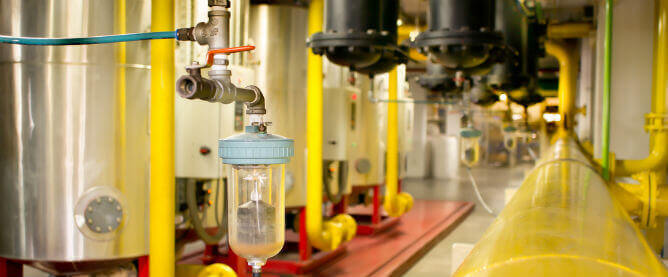Desiccant Dryers and Their Function in Compressed Air Treatment

When compressed air has a job to do—power valves, coat parts, carry ingredients, or keep instruments precise—water vapor becomes the quiet saboteur. Just a few extra grams of moisture can cause corrosion, coating defects, or sensor drift.
Desiccant dryers step in where refrigerated dryers can’t, delivering extremely low-pressure dew points that protect the most sensitive applications. This guide explains why they matter, how modern systems like the FDS Series Desiccant dryers and similar technologies operate, what happens inside during moisture removal, and how consistent dry air improves reliability while minimizing contamination risks.
It also covers practical maintenance practices to keep the dryer performing like day one for years. If moisture control is mission-critical in your compressed air system, this guide is your complete playbook.
Why desiccant dryers are critical in sensitive applications
In many industries, “dry enough” isn’t actually dry enough. Sectors such as pharmaceutical production, food and beverage packaging, semiconductor fabrication, paint and powder coating, instrument air for refineries, and outdoor or cold-climate operations often demand pressure dew points as low as −40°C to −70°C (−40°F to −94°F). At those levels, water vapor cannot condense in pipelines or equipment, even during sudden pressure drops or freezing conditions.
Refrigerated dryers typically deliver a pressure dew point (PDP) of around +3°C to +7°C (+37°F to +45°F)—adequate for general manufacturing, but not for moisture-sensitive environments. In contrast, desiccant dryers routinely achieve ISO 8573-1 humidity Class 2 (≤ −40°C PDP) and, with advanced media and design, Class 1 (≤ −70°C PDP).
That margin matters. It prevents downstream corrosion, avoids pneumatic sticking, eliminates micro-blistering in coatings, and ensures stable, accurate instrument readings.
There’s also a quality and compliance dimension. Many regulated environments—such as GMP, HACCP, and critical utilities in life sciences—document compressed air specifications by class. Specifying a desiccant dryer bridges the gap between “typical” dryness and the verified dryness those standards require.
For expert insights and reliable drying technology designed to meet stringent air quality standards, visit https://pneutech.com/.
Overview of FDS series and comparable technologies
The FDS series, representative of modern twin‑tower, pressure swing adsorption (PSA) desiccant dryers, embodies the core features operators look for: secure dew points, stable cycling, and intelligent energy control. While exact implementations vary by manufacturer, this class of dryer typically includes:
- Twin adsorption vessels (towers) filled with activated alumina, silica gel, or molecular sieve
- Fast‑acting switching valves and a PLC/MLC to control cycle timing
- Coalescing prefiltration and particulate afterfiltration to protect the desiccant and the process
- Dew‑point dependent switching (DPD) or load‑adaptive algorithms to cut purge consumption when demand is light
Comparable technologies in the desiccant category include:
- Heatless (purge) dryers: Simple, robust PSA designs using 12–18% of rated flow as purge air. Reliable and widely deployed.
- Heated purge dryers: Add low‑watt density heaters to reduce purge percentages, often into the 6–8% range.
- Blower purge dryers: Use an ambient air blower and heater to regenerate, minimizing loss of compressed air.
- Heat‑of‑compression (HOC) dryers: Harness the compressor’s discharge heat for near‑zero purge regeneration, highly efficient when conditions align.
- Membrane dryers: Compact, low‑flow solutions for point‑of‑use drying: typically not suited for very large flows or the driest dew points.
Choosing among these depends on flow, target dew point, energy strategy, and available utilities. FDS‑type twin‑tower systems remain the default for achieving −40°C PDP at scale with predictable control.
Moisture removal processes in desiccant dryer systems
At the heart of a desiccant dryer is adsorption, the physical adherence of water vapor to the surface of a porous solid. The desiccant media provides an enormous internal surface area with active sites that attract polar water molecules.
The adsorption cycle
A typical twin‑tower PSA dryer cycles between two parallel vessels:
- Drying: Compressed air enters the “on‑stream” tower. Water vapor adsorbs to the media until it approaches a designed loading threshold.
- Depressurization: The “off‑stream” tower is slowly depressurized to ambient to prepare for regeneration.
- Regeneration: A small portion of the already‑dried air (heatless), or heated ambient air (blower purge), or heat from the compressor discharge (HOC) desorbs the water from the saturated media, carrying it out a purge exhaust. Heat energizes water molecules to leave the adsorption sites: low partial pressure helps drive them off.
- Repressurization: The regenerated tower returns to line pressure to avoid pressure shocks when it switches to on‑stream.
This sequence repeats automatically. In heatless PSA designs, the purge rate often sits around 12–18% of rated flow: with dew‑point control, it drops significantly during low load. Heated variants lower compressed‑air losses further by adding sensible heat to the media.
Desiccant media choices
- Activated alumina: Durable, cost‑effective, great for −40°C PDP targets and oil‑tolerant when protected by proper filtration.
- Silica gel: Strong water capacity at higher dew points, vulnerable to liquid water and oil carryover.
- Molecular sieve (3A/4A): Highest affinity for water at very low partial pressures: best for ≤ −70°C PDP or very cold climates.
Controls that protect performance
Modern dryers use dew‑point sensors and algorithms to extend cycles when the air is already dry, reducing purge and heat input. Valve sequencing is tuned to minimize pressure drop and avoid attrition of the media. Proper prefiltration is non‑negotiable: coalescing filters must remove aerosols and liquid water before the dryer, and a particulate afterfilter captures desiccant dust to protect downstream components.
The result is consistent pressure dew point, even as flow fluctuates, a key requirement for processes that can’t tolerate surprises.
Reliability benefits from consistent dry air delivery
Stable, low dew points translate directly into uptime and asset protection.
- Corrosion control: Dry air halts rust in carbon steel piping, prevents pitting in valves, and reduces blockage from scale. Fewer leaks and longer pipe life follow.
- Instrument integrity: Pneumatic positioners, I/P transducers, and analyzers stay accurate when moisture doesn’t condense in tiny orifices. That means tighter control loops and fewer nuisance trips.
- Coating and finish quality: Paint blush, fisheyes, and micro‑blistering trace back to moisture and oil. Consistent dryness preserves surface quality and rework rates drop.
- Cold‑weather resilience: With −40°C PDP, ice won’t form in outdoor lines or air starters. Startups stay predictable in winter.
- Lubrication and wear: Water in air tools and cylinders emulsifies lubricants. Dry air preserves films and extends seal life.
Less corrosion and fewer sticking components mean fewer unscheduled shutdowns. Plants often see maintenance move from firefighting to planned work once dew points are under control.
Reducing contamination risks through desiccant technology
Moisture is a force multiplier for contamination. It dissolves and transports metal ions, fuels microbial growth in some applications, and makes fine particles agglomerate. Desiccant dryers cut off those pathways.
- With proper coalescing prefilters, oil aerosols and liquid water are removed upstream, protecting the desiccant bed from fouling and keeping downstream air cleaner.
- A high‑efficiency afterfilter captures desiccant fines, preventing particulates from reaching valves, nozzles, or product contact points.
- Low relative humidity reduces microbial viability in distribution piping for facilities that also manage sterility with filtration or sterilization steps.
In regulated industries, clear specifications help: pairing desiccant drying for water vapor control (ISO 8573‑1 humidity Class 1 or 2) with appropriate oil and particle classes builds a defensible compressed air quality plan aligned to HACCP or GMP risk assessments. The payoff is fewer product holds and cleaner audits.






